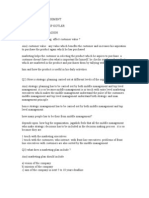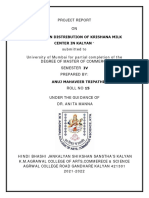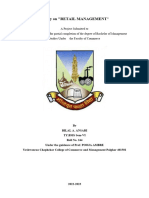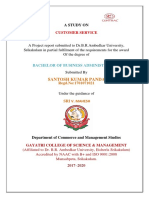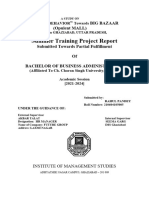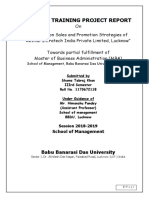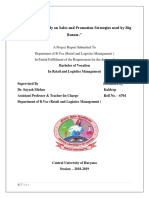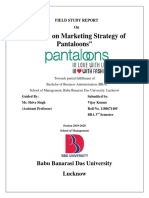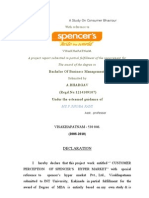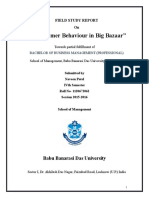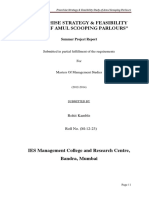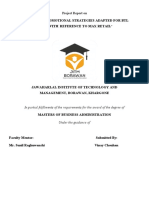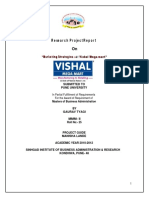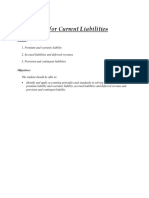To Study Customer Relationship Management in Big Bazaar
To Study Customer Relationship Management in Big Bazaar
Uploaded by
Abhi KengaleCopyright:
Available Formats
To Study Customer Relationship Management in Big Bazaar
To Study Customer Relationship Management in Big Bazaar
Uploaded by
Abhi KengaleOriginal Title
Copyright
Available Formats
Share this document
Did you find this document useful?
Is this content inappropriate?
Copyright:
Available Formats
To Study Customer Relationship Management in Big Bazaar
To Study Customer Relationship Management in Big Bazaar
Uploaded by
Abhi KengaleCopyright:
Available Formats
“To study customer relationship management in big
bazaar”
A Project Submitted to
University of Mumbai for partial completion of the degree of
Bachelor of Management Studies
Under the Faculty of Commerce
By
Mr. Adarsh Gupta
Under the Guidance of
Prof. Ravi M Ahuja
LAXMAN DEVRAM SONAWANE COLLEGE OF
ARTS, COMMERCE, BMS & BAF, KALYAN (WEST).
March 2022
Board of Studies-in-Business Management, University of Mumbai 116 | P a g e
CERTIFICATE
This is to certify that Ms. Adarsh Gupta has worked and duly
completed her Project Work for the degree of Bachelor of Accounting
and Finance Studies under the Faculty of Commerce in the subject of
Accounting her project is entitled, To study customer
relationship management in big bazaar under my supervision.
I further certify that the entire work has been done by the learner
under my guidance and that no part of it has been submitted
previously for any Degree or Diploma of any University.
It is her own work and facts reported by her personal findings and
investigations.
Seal of the College Name and Signature Of
Guiding Teacher
Date of Submission :
Board of Studies-in-Business Management, University of Mumbai 117 | P a g e
DECLARATIONS
I the undersigned Mr. Adarsh Gupta here by, declare that the work
embodied in this project work titled “To study customer
relationship management in big bazaar” forms my own
contribution to the research work carried out under the guidance of
Prof. Ravi M Ahuja is a result of my own research work and has not
been previously submitted to any other University for any other
Degree/ Diploma to this or any other University.
Wherever reference has been made to previous works of others, it
has been clearly indicated as such and included in the bibliography.
I, here by further declare that all information of this document has
been obtained and presented in accordance with academic rules and
ethical conduct.
Adarsh Gupta
Name and Signature of the learner
Certified by
Name and Signature of The Guiding Teacher
Board of Studies-in-Business Management, University of Mumbai 118 | P a g e
ACKNOWLEDGEMENT
To list who all have helped me is difficult because they are so
numerous and the depth is so enormous.
I would like to acknowledge the following as being idealistic
channels and fresh dimensions in the completion of this project.
I take this opportunity to thank the University of Mumbai for
giving me chance to do this project.
I would like to thank my Principal, Ms. Annie Antony for
providing the necessary facilities required for completion of this
project.
I take this opportunity to thank our Coordinator, Faculty Members
for their moral support and guidance.
I would also like to express my sincere gratitude towards my
project guide Prof. Ravi M Ahuja whose guidance and care made the
project successful.
I would like to thank my College Library, for having provided
various reference books and magazines related to my project.
Lastly, I would like to thank each and every person who directly or
indirectly helped me in the completion of the project especially my
Parents and Peers who supported me throughout.
Students name
- RESEARCHER
Board of Studies-in-Business Management, University of Mumbai 119 | P a g e
TABLE OF CONTENTS
Sr. No Topic
Ch 1. Introduction
1.1 Overview of Industry as a whole
1.2 Profile of the Organization
1.3 Problems of the Organization
1.4 Competition Information
1.5 S.W.O.T. Analysis of the Organization
Ch 2.
Object & Methodology
2.1 Significance
2.2 Managerial usefulness of the study
2.3 Objective
2.4 Scope of the Study
2.5 Methodology
Ch 3 . Conceptual Discussions
Ch 4. Data Analysis
Ch 5. Findings and Recommendations
Annexure
Bibliography
Board of Studies-in-Business Management, University of Mumbai 120 | P a g e
CHAPTER-1
INTRODUCTION
OVERVIEW OF THE INDUSTRY AS WHOLE
The Indian retail industry is now beginning to evolve in the line with the transformation that
has swept other large economies. The liberalization of the consumer goods industry initiated
in the mid-80 and accelerated through the 90’s has begun to impact the structure and conduct
of the retail industry.
The concept retail which includes the shopkeeper to customer interaction, has taken many
forms and dimensions, from the traditional retail outlet and street local market shops to
upscale multi brand outlets, especially stores or departmental stores.
The objective being to assess the various parameters that influences a buyer to visit or shop at
departmental store thereby contributing to its turnover (in terms of sales and profits) hence
leading to its overall success.
The extensive research brought me to conclude that departmental stores are soon emerging on
the top priority lists, amongst the shopping spree in Delhi and NCR, as they seem to derive
immense pleasure of convenience and exposure to variety under one roof, in their extremely
busy lives, when they don’t have time for things.
Though some of the customers perceive departmental stores to be expensive and only high
income category’s cup of tea, the stores make constant efforts to induce them to at least visit
the store at once during the sale period, or discount offers.
Board of Studies-in-Business Management, University of Mumbai 121 | P a g e
The Retail Marketing Revolution - An Introduction
“Any business that directs its marketing efforts towards satisfying the final consumer
based upon the organization of selling goods and services as a means of distribution”
By 2010, the list of India's top 10 retailers will have at least 5 Indian corporate. Retail
Marketing will go through a tremendous change in India this millennium. It will change
India's cities, its people, and its households. The Indian consumer is reportedly the largest
spender in Singapore and London. It is, therefore, strange that there have, so far, been few
efforts to present the product in the right kind of environment in India.
Indeed, the right shopping experience does induce Indian consumers to spend more. This is
evident from the experiences of retail-outlets like Music.
World, Big Bazaar, Spencer’s, Crosswords, The Home Store, Ebony, Bigjo’s, Saboos,
Standard, Nanz, Vijay Store and Janaki Das & Sons, Westside etc.
Factors affecting Retail marketing
The development of organized retail is dependent on the efforts of several agencies and
institutions. A glimpse of the last 2 decades of the previous century proves illuminating.
Large-format retailing started with outlets like Vivek's and Nalli's in Chennai and Kidskemp
in Bangalore, and, at another level, with manufacturer-retail brands like Bata, Bombay
Dyeing, and Titan.
Government:
The first among these is the government. In a country as big as India and with as many states
as ours, it is imperative that the Central government and all state governments bring in Value
Board of Studies-in-Business Management, University of Mumbai 122 | P a g e
Added Taxation or a unified taxation system to ensure that the tax-regimes are the same
across the country.
The laws governing retail real estate should also be looked into, so that it is possible to
develop retail-estate beyond the city-limits. Apart from providing entertainment and retail
opportunities, this will also decongest the city center and facilitate the development of
suburbs. The relevant rules should also be amended to allow retail-stores to operate 7 days a
week, 12 hours a day.
Nuclear Families:
Given the hours most urban consumers keep at work, and keeping in mind the increase in the
number of nuclear families, this may, indeed, make sense. This will also help people enjoy
their evenings, out at malls.
Developers:
The second group, whose participation is essential in making retail a boom-sector in this
millennium, comprises developers. Most properties are developed without considering the
end user; thus, we sometimes find high-Ceilinged offices and low-ceilinged retail stores.
Often, the shopper's convenience is not taken into consideration while the property is
constructed.
Manufacturers:
There's a lot at stake here: even so early in the 21st Century, India is too large a market to be
ignored by transnational retail giants. From the manufacturing company's perspective, the
focus should be on producing good products, and forging relationships with organised retail.
Manufacturers need to draw a plan of producing quality products and tie in with retailers.
Indeed, the birth of organised retail will also engender the creation of private labels and
store-brands. Thus, if a manufacturing company lacks the resources to build a brand, it can
supply to a retail-chain that has the resources to create a brand of its own.
Board of Studies-in-Business Management, University of Mumbai 123 | P a g e
Indian Consumers:
And even as these developments were taking place, the Indian consumer became more
mature. Customer-expectations zoomed. Thus, at the beginning of the New Millennium,
retailers have to deal with a customer who is extremely demanding. Not just in terms of the
product-quality, but also in terms of service, and the entire shopping experience.
Today, the typical customer who shops in a retail outlet compares the time spent at the check-
out counter with that at an efficient petrol station, and the smile of the counter-person to that
decorating the face of a Jet Airways' crew member. To cope with the new customer,
manufacturers have to focus on product quality and brand building. And retailers, in turn,
have to focus on the quality of the shopping experience.
In this millennium, like in the last, customers will want to spend time with their family and
friends. They may like to visit an outlet on weekends where everything will be available
under one roof. India will benefit from these developments
because of increased consumption through retailing and the corresponding increase in
employment created by retailing.
Retail organizations exhibit great variety and new forms keep emerging. There are store
retailers, non store retailers, and retail organizations.
Consumers today can shop for goods and services in a wide variety of stores. The best-known
type of retailer is the department store. Japanese department stores such as Takashimaya and
Mitsukoshi attract millions of shoppers each year. These stores feature art galleries, cooking
classes, and children’s playgrounds.
The success of the retail stores, therefore, depends on customers’ reaction to the retailing mix
which influences the profits of the store, its volume of turnover, its share of the market, its
image and status and finally its survival.
Board of Studies-in-Business Management, University of Mumbai 124 | P a g e
Trends In Retail Marketing
At this point, I can summarize the main development retailers and manufacturers need to take
into account as they plan their competitive strategies.
In India the trends are mainly in three sectors. These sectors are:
Trends in retail marketing
Urban Suburban Rural
New retail forms and combinations continually emerge. Bank branches and ATM counters
have opened in supermarkets. Gas stations include food stores that make more profit than the
gas operation. Bookstores feature coffee shops.
The electronic age has significantly increased the growth of non store retailing consumers
receive sales offers in the mail and over television, computers, and telephones, to which they
can immediately respond by calling a toll-free number or via computer.
Competition today is increasingly intertype, or between different types of store outlets.
Discount stores, catalog showrooms, and department stores all compete for the same
consumers. The competition between chain superstores and
Smaller independently owned stores have become particularly heated. Because of their bulk
buying power, chains get more favorable terms than independents, and the chains’ large
square footage allows them to put in cafes and bathrooms.
Board of Studies-in-Business Management, University of Mumbai 125 | P a g e
Today’s retailers are moving toward one of two poles, operating either as mass merchandisers
or as specialty retailers. Superpower retailers are emerging. Through their superior
information systems and buying power, these giant retailers are able to offer strong price
savings. These retailers are using sophisticated marketing information and logistical systems
to deliver good service and immense volumes of product at appealing prices to masses of
consumers.
Many retailers are even telling the most powerful manufacturers what to make; how to price
and promote; when and how to ship; and even how to reorganize and improve production and
management. Manufacturers have little choice: They stand to lose 10 to 30 percent of the
market if they refuse.
Technology is becoming critical as a competitive tool. Retailers are using computers to
produce better forecasts, control inventory costs, order electronically from suppliers, send e-
mail between stores, and even sell to
Customers within stores. They are adopting checkout scanning systems, electronic funds
transfer, and improved merchandise-handling systems.
Retail Marketing In India
There are various ways of making goods available to consumers like:
Company to distributor to wholesaler to retailer to consumer
Company to salesperson to consumer
Company to consumers (online/ phone/ catalog ordering)
These three are among the most common ways of making the goods available to consumers.
But in India the three layered system of distributor, wholesaler and retailer, forms the
backbone of the front-end logistics of most of the consumer-good companies.
Board of Studies-in-Business Management, University of Mumbai 126 | P a g e
There are a number of reasons behind this fragmented retail market. Some of the major
reasons being:
Poverty and lower literacy levels.
Low per capita income.
Savings focused and less indulgence mindset.
Poor infrastructure facilities like roads etc.
Restrictions on intra-state good movement.
High taxes.
No exposure to media.
High import duties on imported goods.
FDI in retailing is not allowed.
CRM In Retail Marketing( Big Bazaar)
Customer relationship activities have the most impact on customer
retention. Every customer service encounter has the potential to gain
repeat business or have the opposite effect. The expectation of
personalized, relevant offers and service is becoming a primary driver
of customer satisfaction and retention in financial services.
What Exactly Is CRM?
The first thing you find when looking into the world of Customer Relationship Management is the
number of different definitions in use today.
Here is the one I have chosen for this Project:
"CRM is the business strategy that aims to understand, anticipate, manage and
personalize the needs of an organization's current and potential customers" -- PWC
Consulting .
Board of Studies-in-Business Management, University of Mumbai 127 | P a g e
CRM is a business strategy, one that puts the customer at the heart of the business.
“That’s nothing new” I hear you say, and you would be right. Good business people
have always understood the relationship between happy customers that come back
again and again and creating long term, sustainable profitability. Big Bazaar has
realized this and applied this to effect.
One just needs to think of the local shop owner who knew everyone of his customer’s names,
birthdays and particular ailments to prove that point. What is new is that there now exists the
technology to enable this customer-centricity on a much larger scale.
(“Come To Big Bazaar- IsseSastaAurAchhaKahinNahin”)
It is said that a successful CRM implementation will allow your Customer Service, Sales and
Marketing people (and anyone else in your organization) to have a holistic view of each and
everyone of your customers. In theory this will enable them to make quick, informed
decisions, create cross selling and up selling opportunities, measure marketing effectiveness
and deliver personalized Customer Care. Sound’s great doesn’t it !!!
The History of CRM
Following on from Enterprise Resource Planning or ERP (the business strategy that promised
to automate the “back-office”), the term CRM was first coined in the mid-1990s. CRM in
those days referred to the software used to help businesses manage their customer
relationships. From sales force automation software (SFA) that focused on customer contact
management to integrated knowledge management solutions, these were the early
foundations of CRM.
Board of Studies-in-Business Management, University of Mumbai 128 | P a g e
The last couple of years have seen the term broaden to encompass a more strategic approach
and the investment of billions of dollars worldwide into CRM solutions and services has
followed.
First Things First
Successful CRM always starts with a business strategy, which drives change in the
organization and work processes, enabled by technology. The reverse rarely works. The key
here is to create a truly Customer-Centric philosophy that touches every point and more
importantly every person in the company. From CSR to CEO everyone must live and breathe
customer focus for all of this to work.
The Right Technology
It is estimated that the global market for CRM services and solutions is currently worth $148
billion. That means a lot of choice when selecting your technology - from web-based
solutions aimed at small businesses with less than 10 employees to solutions suitable for
multi-national enterprises with millions of customers.
The Future
CRM has already made a big impact in the world of Customer Service and will continue to
do so. As more and more companies become customer-centric those that fail to do so will
lose competitive advantage. As technology increases to develop at a startling rate the key
emphasis will be how we can fully utilize it within our business.
However let's not lose sight of the fact that Customer Relationship Management is about
people first and technology second. That’s where the real value of CRM lies, harnessing the
potential of people to create a greater customer experience, using the technology of CRM as
the enabler.
Board of Studies-in-Business Management, University of Mumbai 129 | P a g e
Advantages Of CRM for Big Bazaar
Using CRM, at the management of Big Bazaar can:
Provide better customer service
Increase customer revenues
Discover new customers
Cross sell/Up Sell products more effectively
Help sales staff close deals faster
Make call centers more efficient
Simplify marketing and sales processes
By applying this methodology Big Bazaar learned more about customers' needs and
behaviors in order to develop stronger relationships with them. They implemented CRM as a
process that brought together lots of pieces of information about customers, sales, marketing
effectiveness, responsiveness and market trends.
CRMhelps businesses use technology and human resources to gain insight into the behavior
of customers and the value of those customers.
Challenges For Big Bazaar in CRM implementation:
.Difficulty in acquiring new customers can be a result of any one, or combination, of
the following problems.
.Inaccurate and Slow Quoting Organizations may be unable to accurately estimate
and quickly deliver successful proposals, often leading to missed opportunities, bad
profit margins and upset prospects.
Lack of Product Knowledge Within their Sales Force
Problems can arise when products were sold that didn’t fit company's profitability
strategy such as selling a customer one product when another would be better for the
customer and more profitable for you.
Difficulty and Delay in Updating Pricing and Product Information
Board of Studies-in-Business Management, University of Mumbai 130 | P a g e
When the sales force is relies on incomplete product, pricing and customer
information, then they're probably not selling the most profitable products you
offer.
Customers prefer a combination of differing channels in which to deal with your
company. Self-service on the web can even be done for complex products. Plus, self-
service on the web offers retail banks the opportunity to shift cost out to the
customer.
Customer Satisfaction Is Big Bazaar
“The degree of customer satisfaction you deliver determines the level of long-term success
you will achieve in business.” - --- Training Mantra for Sales Force
Customer Satisfaction their Top Priority
Don't just make sales. Create customers - satisfied customers. In addition to the immediate
profit they provide on the first sale, satisfied customers help you build your business in 2
other important ways:
1. They become a reservoir of repeat buyers. For some businesses that means repeat buyers
for more of the same product or service. For every business, it means buyers for additional
products and services.
2. They automatically refer more business to you from their friends and business contacts.
This is highly profitable business for you because it doesn't cost you any time or money to get
it.
Whatever they Promise More, they Deliver
Never make any promises you can't (or won't) keep. Nothing alienates customers faster than
getting something less than they expect from a business transaction. They won't do business
with you again. And they will tell everybody they know about their unhappy experience -
causing you to lose future customers.
Board of Studies-in-Business Management, University of Mumbai 131 | P a g e
Always Give Customers More Than They Expect
"Over deliver" on quality and service. Always exceed your customers' expectations. You will
win their long term loyalty. It also makes it difficult for competitors to steal customers from
you - even if they have lower prices. Customers will not risk an uncertain experience with a
competitor when they know they will get more than they expect from you.
Customers know how much they value them:
Let your customers know you are always thinking about them. Communicate with them
regularly. For example, create some special deals just for your existing customers. And
announce new products or services to them before you announce them to the general market.
PROCESS OF CRM
Customer Relationship Management (CRM) is the process of bringing the customer
and the company closer together. There are many different areas in which Customer
Relationship Management can be implemented. The goal of CRM is to help a
company maintain current customers, as well as gain new customers.
Targeted Marketing: Targeted marketing is accomplished through collecting
information about the customer. This information can be buying habits or simply
demographics. The idea behind this is that a business analyzes what a customer buys
and then markets specific products to that customer based on his or her buying habits.
Businesses track buying habits using discount cards, and special store credit cards.
Targeted marketing can also be implemented on the Internet. Amazon.com has
product recommendations based on buying habits, and product ratings. Customers can
also be sent e-mails that market targeted products. Marketing the right products to the
right customers can significantly increase a business' sales with minimal associated
costs.
Board of Studies-in-Business Management, University of Mumbai 132 | P a g e
CONSUMER BEHAVIOR
Options: Consumers are more likely to choose an alternative after a relatively
inferior option is added as a choice. For example, Simonson says, participants in one
study were given a choice
between $6 and an elegant Cross pen. A second group chose among $6, the
same Cross pen, and a second pen that was clearly less attractive than the Cross
pen. As was predicted, the addition of the unattractive pen increased the share of
the Cross pen at the expense of the $6.
Alternatives: Consumers prefer alternatives that are compromise choices. Given a choice
between two alternatives, one priced lower than the other, the addition of a third choice,
priced higher than both, will increase the market share of the more expensive of the original
two. This finding suggests that companies can increase their overall sales and shift purchases
to higher-margin items by carefully designing the sets of alternatives that their customers
consider.
Floor Displays: Buyers are averse to choosing the lowest-quality alternative in sets
of three or more choices. One of the implications of this finding is that marketers of
well-known, high-priced brands should encourage retailers to organize floor displays
by model type, whereas marketers of lesser-known, lower-priced brands should
prefer organization by brand.
Brands: Consumers who think about the possibility that their purchase decisions will be
wrong are more likely to choose better known brands. In a test case, Simonson showed
that consumers debating between a better known, more expensive brand and a lesser-
known, less expensive brand expect to feel greater regret if they err by choosing the
cheaper option. Indeed, after thinking about the possibility of regret, consumers were
more likely to select the better-known brand. Kodak film has capitalized on this finding
with an advertising campaign that asks consumers to consider how they would feel if
they bought cheap film and their pictures didn't turn out.
Preferences: Consumers tend to select variety when buying multiple products for
consumption at a later time. In each of three weeks, Simonson asked a group of respondents
to select one of six familiar snacks for immediate consumption. A second group was asked to
pick three snacks -- one for immediate consumption and one for each of the next two weeks.
Board of Studies-in-Business Management, University of Mumbai 133 | P a g e
Both groups were told that they could pick the same snack as many times as they wished.
Those in the first group tended to select the same snack all three times, whereas most in the
second group selected three different snacks.
Product Modifications: Modifying a product with a feature or premium that is of
little or no value to the consumer, even without raising the price, may actually
decrease sales. When consumers are uncertain about their preferences, a product
that offers an unneeded add-on (such as an offer to purchase a Pillsbury Doughboy
collector's plate) provides them with a reason for rejecting it.
While marketing professionals can use these findings to influence consumer decision
making, consumers, too, can benefit by understanding their own behavior. "One of the
points of our research is to inform consumers about some of the factors that influence
their decisions," Simonson says. "With such knowledge, they may be able to make
better, more thoughtful decisions."
1.5 SWOT Analysis of Big Bazaar
Strength
Prime location
Large floor space allowing for better visual merchandising
Large area also allows to stock a large variety of products under one roof
Experienced and competent management
Highly trained and motivated sales force
Brand equity
Large scale operations in various cities throughout the country allows them to
reap the benefits of “economies of scale”
Board of Studies-in-Business Management, University of Mumbai 134 | P a g e
Weakness
Large scale of operations sometimes acts as a barrier to personalized customer
relations
Large scale operations lead to reduced flexibility by increasing the amount of
overheads and a huge commitment in terms of fixed costs
A large organization structure leads to delayed decisions. This can prove fatal for
a business in the dynamic fashion industry. Mumbai, this fact sometimes results in
delayed decisions in adapting to changing market trends
Opportunities
Apart from the metros, cities like Ahmadabad, Pune, Lucknow, Indore and
Coimbatore have shown substantial retail presence. Most sport modern retail
formats like supermarkets, department stores and specialty chains. These markets
are expected to show exponential growth in the next few years. Thus Food Bazaar
has the opportunity to explore new markets
According to the Consumer Outlook study, consumers are generally satisfied with
the service that organized retailers extend to them. More importantly, they are
increasingly regarding these organized retailers as providing `value-for-money’.
These findings indicate that large retailers will capture most of the higher
consumer spending
Increasing penetration of the internet into Indian homes has provided Food Bazaar
Mall to break the geographical barriers and to increase their customer base. The
entry into online retailing, would, in fact, expand the product categories available
to the consumer
Board of Studies-in-Business Management, University of Mumbai 135 | P a g e
Threats:
The time when retailers had to worry about competition only from their peers
down the street has come to an end. Food Bazaar is now facing increased
competition in the form of international retail chains that are making a beeline
towards the highly potential Indian markets. Moreover many big Indian business
houses are also vying a space in the Indian retail scene .
Board of Studies-in-Business Management, University of Mumbai 136 | P a g e
Chapter 4 – Data Analysis
RESULT OF SURVEY ON CRM IN RETAIL MANAGEMENT
(BIG BAZAAR)
CUSTOMER SURVEY
1. Are you satisfied with the services provided by Big-Bazaar?
YES 20
NOCAN’T SAY 5 5
25
20
15
Series1
10
0
YES NO CAN'T SAY
Result:
From the above table it is clear that customers are satisfied with the services of Big Bazaar
because out of 30 customers 20 has given the positive answer in favor of Big Bazaar.
Board of Studies-in-Business Management, University of Mumbai 137 | P a g e
2. How do you find the Shopper Assistant’s behaviour?
18 7 5
HELPING NOT HELPING RUDE
20
18
16
14
12
10 Series1
8
6
4
2
0
G G E
IN IN D
P P U
L L R
E E
H H
T
O
N
Result:
From the above table it is clear that customer are satisfied with the attitude of the shopper’s .Out of
30 customer all 18 customer are satisfied.
Board of Studies-in-Business Management, University of Mumbai 138 | P a g e
3. How would you rate the Shopper Assistant’s behavioron the scale of five?
10
54 3 14
3 2 05
2 1 11 00
Series1
3
Series2
0 2 4 6 8 10 12 14 16 18 20
Result:
Out of 30 customer,11customer have given the 5 marks
to shopper . Assistant behavior while 14 has given 4 marks&5 has given 3 marks
Board of Studies-in-Business Management, University of Mumbai 139 | P a g e
4. Do you find the Layout of Food-Bazaar helpful in Shopping Experience?
20 8 2
YES NO CAN’T SAY
can't say
2
no
8
yes
20
0 5 10 15 20 25
Series1
Result:
Out of 30 customers, 18 have told that they like the layout of Big Bazaar while 8 told that they do not
like very much.
Board of Studies-in-Business Management, University of Mumbai 140 | P a g e
5. What do you like most about Big-Bazaar ?
7 5
CREDIT FACILITY TRANSPORTATION FACILITY
18
DELIVERY SERVICES
20
15
10 Series1
18
5
7
5
0
Cr.Facility Tr.Facility Dl.facility
Result:
Out of 30 Customer, 18 customers like delivery services of Big Bazaar while 7
customers like the credit facility&5 customers like transportation facilities. So it
is clear that customer wants delivery services most.
Board of Studies-in-Business Management, University of Mumbai 141 | P a g e
6. How often do Big-Bazaar services exceed your expectations? (Customer
Delightness)
ALWAYS 18 SOMETIMES NEVER
9
3
20
15
10 18 Series1
5 9
0 3
S ES
AY
IM VER
W T E
AL M
E N
SO
Result:
Out of 30 Customers ,18 customers said that Big Bazaar always provide better
services &it exceed their expectation.
Board of Studies-in-Business Management, University of Mumbai 142 | P a g e
7. Do you think that Big-Bazaar follow the ethical Mktg. Practices like right
pricing, right quality and right quantity?
25 5 0
YES NO CAN’T SAY
30
25
20
15 Series1
25
10
5
5
0 0
Yes No Can'tsay
Result:
Out of 30 customer,25 customers have told that BigBazaar following the
ethical marketing practices.
Board of Studies-in-Business Management, University of Mumbai 143 | P a g e
8. What comes first when you think about Food–Bazaar?
10
PRICE 20 QUALITY
QUALITY
33%
PRICE
67%
Result:
Customer said that when they think about Big Bazaar they think about price.
out of 30 customer 20 customer have told this while 10 customer said that
they think about quality.
Board of Studies-in-Business Management, University of Mumbai 144 | P a g e
9. How would you rate theme–setting display of Food-Bazaar in comparison to
other?
9 18 3 0
EXCELLENT GOOD SO-SO BAD
0
WORST
18
20
15
9
10
3
5 0 0
0
T D O D ST
N
E O
O -S BA R
E L L G SO W
O
E XC
Result:
Out of 30 customers, 9 customers said that Food Bazaar theme is excellent
while 18 customers said that it is good &3 customers said that it is ok.
Board of Studies-in-Business Management, University of Mumbai 145 | P a g e
RETAILOR SURVEY
10. What is the most important criteria of selection for their Store Assistant
and Store Manager?
1 5 4
Pleasing Personality Good Communication Team Work
Commitment toward Customer needs 10
10
0
0
4
3
0
2
1
0
1
0 2 4 6 8 10 12
Result:
Out of 20 retailers,10 has given importance to the store manager who have the
quality of identifying customer need, while others have given importance on
work & good communication skills.
Board of Studies-in-Business Management, University of Mumbai 146 | P a g e
11. Do you display all the entire stock on the rack or some amount is kept for
contingence? (Inventory availability)
Applicable to all product 14 Applicable to some product 4
Only to FMCG 2
2
0
4
0 8
3
2 14
1 0
Result:
Out of 20 retailer ,14 have told that they show all the product to customer,
while 4 have told that show some product to the customer.
Board of Studies-in-Business Management, University of Mumbai 147 | P a g e
12. How do you decide of point of purchase counter?
2 2 12 4
Brand Price Customer preference Product visibility
0
3
12
0
2
0
2
1
0
2
0 2 4 6 8 10 12 14
Result :
Out of 20 Retailer, 12 has said they use the customer preference for
point of purchase counter while other said that they use brand
&product visibility.
Board of Studies-in-Business Management, University of Mumbai 148 | P a g e
13.What is the preference order for promotional activity to create customer
awareness?
10 5 1 4
Newspaper Radio jingle Advertising Banner
12
10
8
6
4
2
0
er le ne
r
in
g
a p ng n s
sp ji
B a e rti
io
ew ad A dv
N R
Result :
Out of 20 retailer ,10 has told that they use Newspaper as their main tool for
promotional .
Board of Studies-in-Business Management, University of Mumbai 149 | P a g e
14. How would you analyse the customer satisfaction?
Number of repeat purchase 7 Loyalties benefit 3 Customer 10
database
10
0
0
2
7
1
0
0 2 4 6 8 10 12
Result :
20 Out of Retailer,10 retailer said that they get the customer satisfaction by
customer database while other have said that they use data of number of
repeat purchase.
Board of Studies-in-Business Management, University of Mumbai 150 | P a g e
15. What is your method of analyzing customer satisfaction?
12 5 3
Feedback No. of repeat purchase interaction of manager
With customer
3
2
1
0 2 4 6 8 10 12
Result :
Out of 20retailer, 12 have told that analyzing the customer satisfaction through
the feedback of customer.
Board of Studies-in-Business Management, University of Mumbai 151 | P a g e
Chapter 4- Findings And Recommendation
Findings
In this survey the findings are given below:
1. Most of the stores are targeting almost all the segments of the society with their USP being
“Price benefit”
2. All the stores are in Prime Location.
3. Every Big Bazaar outlet have motivated and trained sales force.
4. Large variety of products are available ranging from clothes, food items, electronic goods
etc.
5. Staff is provided constant training for various peculiarities of customer behavior.
6. Some of them offer discount sales and also send greetings to its loyal customers.
7. Not much difference in the Layout of the floor designs in the various branches. They try to
maintain a similarity to maintain comfort levels of customers.
8. These stores maintain Word of Mouth.
9. Customers are satisfied with the provided services.
10. International shopping experiences can be achieved from these stores.
Board of Studies-in-Business Management, University of Mumbai 152 | P a g e
RECOMMENDATION
1) Convert your customers into publicity agents. Develop an incentive for them to tell
associates and friends about the value of your products or services. An endorsement from
them is more effective than any amount of advertising - and it is much cheaper.
2) Surprise your customers with unexpected value. If you sell products, include an
"unadvertised bonus" with every order. If you sell services, get into the habit of doing
something extra for every customer or client without charging for it.
3) Reward them each time they refer someone who becomes a customer. Your reward can
be as simple as a credit toward their next order from you.
4) The management of BigBazaar can improve their understanding of the role and
capabilities of advertising to improve customer relation and enhance loyalty. This
understanding should in turn results in a more effective and more efficient advertising
campaign.
5)Visual Merchandising: It is often seen that the people come to the store to browse
rather than buy.
6) Schemes: In store Promotions: The people visiting the store should be encouraged to
visit the store again and again. So it is necessary to delight the shoppers with the
shopping experience. It has been observed in
Board of Studies-in-Business Management, University of Mumbai 153 | P a g e
CONCLUSION
“Customer Service is a critical factor for keeping your clients coming back and ensuring
they’ll refer you to others”.
1: Growing your business will be a difficult task at best if you don’t perform, meet and
exceed your client’s expectations, and provide service that creates customers for life.
2: Customer service is all about the customer’s perception. You have to do more than just
get the job done. You must deliver on all the things (big and small) that affect the
relationship with your client. Consider opportunities for improvement in the following
areas.
3: Setting/Reviewing Expectations: Do you work with your client to set clear,
appropriate, realistic expectations that you can always meet or exceed? Are you clear
about the responsibilities (both yours’ and the client’s), timelines, and expectations of
results? Are you then willing to go back and review these expectations with the client at
key points along the way?
4: Communication: Do you have mechanisms in place to ensure you’re communicating
with clients at every stage of the engagement, from the sales process through to
completion of the project? Being clear about where you’re at, what’s been completed,
what’s coming up next, who’s responsible, what results you can expect, etc.? Has the
client ever had to ask you for these things?
5:Organization: Are you organized? Punctual? Reliable? When you show up to work with
your clients, have you done the work and are you prepared to make them feel comfortable
and taken care of? Even though you’ve done it hundreds, maybe thousands of times
Board of Studies-in-Business Management, University of Mumbai 154 | P a g e
before, do you take the time to organize and prepare to make it the best client experience
possible?
6: Committing to the Little Things:Don’t ever dismiss the power of all the little things.
Together they can make all the difference and really separate you from the competition.
Returning calls and emails in a timely manner. Providing useful information to folks on a
regular basis. Showing appreciation for your clients through things like thank you notes,
exclusive client-only briefings, and open house, etc.
Clearly these are not the only relevant areas for creating great customer service, I assure
you. But these were some of the Factors which might
Provide a boost to the sales figures, though I am sure the organization would have already
implemented most of these measures already.
Board of Studies-in-Business Management, University of Mumbai 155 | P a g e
Big Bazaar-Marketing Mix
Product Branding Price
Packaging Cost of goods
Product Design Business Expenses
Assortment Gross Margin
Services Profit
Promotion Distribution
Advertising Logistics
Personal Selling Store Location
Sales Promotion Site Evaluation
Public Relations Transportation
Visual Merchandising Storage of goods
They seem to follow this to the core for effective Customer reach and encourage customer
loyalty.
Board of Studies-in-Business Management, University of Mumbai 156 | P a g e
ANNEXURES
QUESTIONAIRE ON CUSTOMER-RELATIONSHIP
MANAGEMENT IN RETAIL-SECTOR (BIG BAZAAR)
CUSTOMER BASED SURVEY
1.Are you satisfied with the services provided by Big-Bazaar?
YES NO CAN’T SAY
2.How do you find the Shopper Assistant’s behavior?
HELPING NOT HELPING RUDE
3.How would you rate the Shopper Assistant’s behavior on the scale of five?
5 4 3 2 1
4.Do you find the Layout of Big-Bazaar helpful in Shopping Experience?
YES NO CAN’T SAY
6.What do you like most about Bigd-Bazaar ?
CREDIT FACILITY TRANSPORTATION FACILITY
DELIVERY SERVICES
7.How often do Food-Bazaar services exceed your expectations?
ALWAYS SOMETIMES NEVER
Board of Studies-in-Business Management, University of Mumbai 157 | P a g e
8. Do you think that Food-Bazaar follow the ethical Mktg. Practices like right pricing, right quality and
right quantity?
YES NO CAN’T SAY
9 What comes first when you think about Food–Bazaar?
PRICE QUALITY
10 How would you rate theme–setting display of Food-Bazaar in comparison to other?
EXCELLENT GOOD SO-SO BAD WORST
NAME…………………………. ADDRESS………
Board of Studies-in-Business Management, University of Mumbai 158 | P a g e
QUESTIONAIRE ON CUSTOMER-RELATIONSHIP
MANAGEMENT IN RETAIL-SECTOR (Big BAZAAR)
RETAILOR BASED SURVEY
1.What is the most important criteria of selection for their Store Assistant and Store Manager?
Pleasing Personality Good Communication Team Work
Commitment Toward Customer needs
2.Do you display all the entire stock on the rack or some amount is kept for contingence?
Applicable to all product Applicable to some product Only to FMCG
3. Rate the following options as per your priorities while deciding the layout for store?
Security m Computerization Parking Air-conditions
4.How do you decide of point of purchase counter?
Brand Price Customer preference Product visibility
5. What is the preference order for promotional activity to create customer awareness?
Newspaper Radio jingle Advertising Banner
6. How would you analyze customer localities factor?
Number of repeat customer localities benefit customer database
7. What is your method of analyzing customer satisfaction?
Feedback No. of repeat purchase interaction of manager with customer
Board of Studies-in-Business Management, University of Mumbai 159 | P a g e
8. What is the training methodology used to enhance customer satisfaction in your
employee ?
Bibliography
Marketing Management
- Philip Kotlar
Research Methodology
- C. R. Kothari
Retail Marketing
J.A.Lamba
Customer Relationship Management
- Jagdish and Seth
www.indiainfoline.com
www.google.com
www.businessline.com
Board of Studies-in-Business Management, University of Mumbai 160 | P a g e
You might also like
- Project Report On Vishal Mega MartDocument64 pagesProject Report On Vishal Mega MartGaurav Tyagi81% (69)
- Shoppers Stop ProjectDocument69 pagesShoppers Stop ProjectDibyendu Das50% (8)
- Research The Organizational Chart and International Business Strategy VinamilkDocument24 pagesResearch The Organizational Chart and International Business Strategy VinamilkKhánh Huyền PhạmNo ratings yet
- Philip Kotler Questions On ManagementDocument29 pagesPhilip Kotler Questions On Managementjagadishprasad88% (32)
- UNIVERSITY OF MUMBAI Black BookDocument71 pagesUNIVERSITY OF MUMBAI Black BookRaj Jaiswal75% (4)
- A Study On Marketing Strategy of PantaloonsDocument28 pagesA Study On Marketing Strategy of PantaloonsChandan Srivastava50% (2)
- Amway ProjectDocument76 pagesAmway ProjectAshish Arya75% (4)
- A Bouquet of Business Case StudiesFrom EverandA Bouquet of Business Case StudiesRating: 3 out of 5 stars3/5 (1)
- Mini Project ReportDocument36 pagesMini Project ReportMohd AhmadNo ratings yet
- Big Bazaar ReportDocument26 pagesBig Bazaar ReportDeepika JaiswalNo ratings yet
- Big Bazaar Marketing StrategyDocument36 pagesBig Bazaar Marketing Strategysharad50% (2)
- A Study On Merchandise PlanningDocument54 pagesA Study On Merchandise PlanningSatya Prakash Singh100% (1)
- Final Project On A Study On Customer Satisfaction Store Operarations and Footfall Management at Retail StoreDocument74 pagesFinal Project On A Study On Customer Satisfaction Store Operarations and Footfall Management at Retail StoreNayan bondeNo ratings yet
- Final ReportDocument57 pagesFinal ReportRajumauryaNo ratings yet
- Deepika NigamDocument60 pagesDeepika NigamMohit AgarwalNo ratings yet
- Customer Satisfaction and Promotional ActivitiesDocument64 pagesCustomer Satisfaction and Promotional Activitiesvishal100% (1)
- To Study Customer Relationship ManagementDocument75 pagesTo Study Customer Relationship ManagementRitika MishraNo ratings yet
- "A Study On Distribution of Krishana MilkDocument72 pages"A Study On Distribution of Krishana MilkPranav PasteNo ratings yet
- Customer Satisfaction Towards Reliance FreshDocument77 pagesCustomer Satisfaction Towards Reliance Freshbhawna100% (3)
- Customer Relationship Management in Retail Sector Big BazaarDocument56 pagesCustomer Relationship Management in Retail Sector Big BazaarEarl Farrago0% (1)
- Retail Management Black BookDocument82 pagesRetail Management Black BookShahrukh KhanNo ratings yet
- Customer Satisfaction at BATADocument65 pagesCustomer Satisfaction at BATAShefali TanejaNo ratings yet
- MBA Final Year ProjectDocument47 pagesMBA Final Year ProjectVicky SharmaNo ratings yet
- Customer Satisfaction at BATADocument65 pagesCustomer Satisfaction at BATAnishant singh67% (3)
- Consumer Behaviour Towards Big BazaarDocument87 pagesConsumer Behaviour Towards Big BazaarSatya Sai Kiran100% (1)
- Bachelor of Business Administration: Axis Institute of Higher EducationDocument56 pagesBachelor of Business Administration: Axis Institute of Higher Educationmd.arsalaan.2020No ratings yet
- Impact of CRM Factors On Customer Satisfaction and Loyalty in Reliance Retail Mall at AhmedabadDocument63 pagesImpact of CRM Factors On Customer Satisfaction and Loyalty in Reliance Retail Mall at AhmedabadManthan MavaniNo ratings yet
- QuestionsDocument40 pagesQuestionsSandy SantoshNo ratings yet
- Consumer Behaviour Towards Big BazaarDocument87 pagesConsumer Behaviour Towards Big Bazaarhimanshupanchal266No ratings yet
- RESEARCH REPORT TO CUSTOMER SATISFACTION ON Vishal Mega MartDocument84 pagesRESEARCH REPORT TO CUSTOMER SATISFACTION ON Vishal Mega MartShahzad Saif100% (1)
- A Study On Sales and Promotion Strategies of Revival Infratech India Private Limited, LucknowDocument90 pagesA Study On Sales and Promotion Strategies of Revival Infratech India Private Limited, LucknowChandan SrivastavaNo ratings yet
- Brijesh ReportDocument101 pagesBrijesh ReportVishwaMohanNo ratings yet
- Chapter 5 Completed 61 ABDocument86 pagesChapter 5 Completed 61 ABmusdqkhan268No ratings yet
- NykaaDocument100 pagesNykaaMahi SharmaNo ratings yet
- Product Mix of MaggiDocument65 pagesProduct Mix of MaggiAnshul Mittal50% (2)
- Financial Analysis of Avenue Supermarts Limited: (A Project With India Ratings and Research PVTDocument47 pagesFinancial Analysis of Avenue Supermarts Limited: (A Project With India Ratings and Research PVTKhushi GandhiNo ratings yet
- Institute of Management Studies Banaras Hindu UniversityDocument48 pagesInstitute of Management Studies Banaras Hindu UniversityLakshit GargNo ratings yet
- Consumer Behaviour Towards Big BazaarDocument87 pagesConsumer Behaviour Towards Big Bazaarjoji thomasNo ratings yet
- 422767Document62 pages422767DivyeshNo ratings yet
- Big BazarDocument87 pagesBig BazarSalman AghaNo ratings yet
- Wrangler SIPDocument53 pagesWrangler SIPShubham MahaleNo ratings yet
- Sip Report #Central MallDocument19 pagesSip Report #Central MallSumit GaraiNo ratings yet
- A Project REPORT ON Market Communication in A New Digital World inDocument67 pagesA Project REPORT ON Market Communication in A New Digital World inSoumya SahooNo ratings yet
- Project Report On: Customer Retention and Ways To Improve Loyalty Program in Pantaloons, Sahara Ganj Lucknow"Document56 pagesProject Report On: Customer Retention and Ways To Improve Loyalty Program in Pantaloons, Sahara Ganj Lucknow"gouri khanduall0% (1)
- Kuldeep PDFDocument46 pagesKuldeep PDFsandeepy604No ratings yet
- Activation of Organised Retail Stores For Personal Care ProductsDocument30 pagesActivation of Organised Retail Stores For Personal Care ProductsAbhishek SharmaNo ratings yet
- A Study On Marketing Strategy of Pantaloons 25Document29 pagesA Study On Marketing Strategy of Pantaloons 25Chandan SrivastavaNo ratings yet
- Business Analytics Process For Sales & Marketing Enhancement of Panchashil HypermarketDocument59 pagesBusiness Analytics Process For Sales & Marketing Enhancement of Panchashil HypermarketANIKETNo ratings yet
- Aayush Vilas Minor Project Reliance TrendsDocument68 pagesAayush Vilas Minor Project Reliance TrendsgamerschoolaaNo ratings yet
- Pepsi Project ReportDocument92 pagesPepsi Project ReportRaza SiddiquiNo ratings yet
- Bhargav ProjectDocument99 pagesBhargav Projectabinashnayak1No ratings yet
- BBM (P) Field Study Report SampleDocument7 pagesBBM (P) Field Study Report SampleJai SinghNo ratings yet
- Study of The Telecom Retailers' Behaviour: Summer Training ReportDocument68 pagesStudy of The Telecom Retailers' Behaviour: Summer Training ReportShashank AggarwalNo ratings yet
- Franchise Strategy & Feasibility Study of Amul Scooping ParloursDocument78 pagesFranchise Strategy & Feasibility Study of Amul Scooping ParloursjndpenzNo ratings yet
- Project ReportDocument12 pagesProject ReportAnkit GehlotNo ratings yet
- Inventory Control HDocument45 pagesInventory Control HChandan SrivastavaNo ratings yet
- Research Projectreport On: of Vishal "Marketing Strategies Mega Mart "Document64 pagesResearch Projectreport On: of Vishal "Marketing Strategies Mega Mart "SanjeevNo ratings yet
- Beginning Part of ProjectDocument12 pagesBeginning Part of ProjectamritgitmNo ratings yet
- PDF CRM in Big BazaarDocument24 pagesPDF CRM in Big BazaarMuhammad TahirNo ratings yet
- Negotiation Strategy TemplateDocument11 pagesNegotiation Strategy TemplateMohamed GhareebNo ratings yet
- Erigo Founder Success StoryDocument4 pagesErigo Founder Success StoryLira Transmisia AodryNo ratings yet
- المقاربة الفكرية الحديثة للإستراتيجية التسويقية 'مع الاشارة إلى نظرية الموارد والكفاءات' Modern intellectual approach to marketing strategy 'with reference to resource and competencies theory'Document15 pagesالمقاربة الفكرية الحديثة للإستراتيجية التسويقية 'مع الاشارة إلى نظرية الموارد والكفاءات' Modern intellectual approach to marketing strategy 'with reference to resource and competencies theory'teNo ratings yet
- Industry Profile On Star BrazarDocument24 pagesIndustry Profile On Star BrazarsunilkumbarNo ratings yet
- Group 7Document14 pagesGroup 7Phấn NguyễnNo ratings yet
- 49-A, S.I.E # 1, Gujranwala-Pakistan, Grand Trunk RD, Industrial Estate, GujranwalaDocument6 pages49-A, S.I.E # 1, Gujranwala-Pakistan, Grand Trunk RD, Industrial Estate, GujranwalaAsadvirkNo ratings yet
- Competitor AnalysisDocument83 pagesCompetitor AnalysisNguyet Vy Dao NguyenNo ratings yet
- Unit 1 MKTDocument26 pagesUnit 1 MKTAman ShuklaNo ratings yet
- Sandeep Gadarla ResumeDocument3 pagesSandeep Gadarla ResumeThe Cultural CommitteeNo ratings yet
- Metahunter Whitepaper - v5.0Document71 pagesMetahunter Whitepaper - v5.0VitaliyNo ratings yet
- Group No 7 Aditya BirlaDocument14 pagesGroup No 7 Aditya Birlapushkar upadhyeNo ratings yet
- ZARA CASE Global MarketingDocument6 pagesZARA CASE Global MarketingMaria Fernanda Velasquez OsorioNo ratings yet
- Bajaj Trendy Hair StraightenerDocument11 pagesBajaj Trendy Hair StraightenerVinayak SinghNo ratings yet
- Assignment 2Document10 pagesAssignment 2Suresh JenaNo ratings yet
- The Accountant's Role in The OrganizationDocument20 pagesThe Accountant's Role in The Organizationzhenka19910% (1)
- Unit B Acctg 4Document14 pagesUnit B Acctg 4Karl Lincoln TemporosaNo ratings yet
- ReflectionDocument2 pagesReflectionMhelrhose HerviasNo ratings yet
- Phase 1 Course RecognitionDocument6 pagesPhase 1 Course Recognitionnicolas rodriguezNo ratings yet
- ACCG 3008 S1, 2020 Business Plan Requirements: (Individual Task - 25%) This Task Is Due 10am, April 2020 (Note New Date)Document10 pagesACCG 3008 S1, 2020 Business Plan Requirements: (Individual Task - 25%) This Task Is Due 10am, April 2020 (Note New Date)Mohit GNo ratings yet
- A Study On Consumer Behaviour With Reference To Big BazaarDocument81 pagesA Study On Consumer Behaviour With Reference To Big BazaarSJS BAZAARNo ratings yet
- SRIVARIDocument45 pagesSRIVARInirmala periasamyNo ratings yet
- 5th Ed - The Tobacco Control Atlas - ASEAN Region - 2021 - FINALDocument188 pages5th Ed - The Tobacco Control Atlas - ASEAN Region - 2021 - FINALAfri yantiNo ratings yet
- Enfresh Juice PresentationDocument19 pagesEnfresh Juice Presentationabhinavgupta_luvu0% (1)
- Product Life CycleDocument12 pagesProduct Life CycleROHIT SINGHNo ratings yet
- Gingoog City Colleges, Inc.: BSBA DepartmentDocument9 pagesGingoog City Colleges, Inc.: BSBA DepartmentShiela Mae MapaloNo ratings yet
- Tiens Marketing PlanDocument22 pagesTiens Marketing PlanKabir Ahmed Kamal100% (2)
- Business Mathematics Chap 10-12Document4 pagesBusiness Mathematics Chap 10-12RECEL ANN RIVERANo ratings yet
- Miriam Handel Resume 8Document1 pageMiriam Handel Resume 8api-700521452No ratings yet



